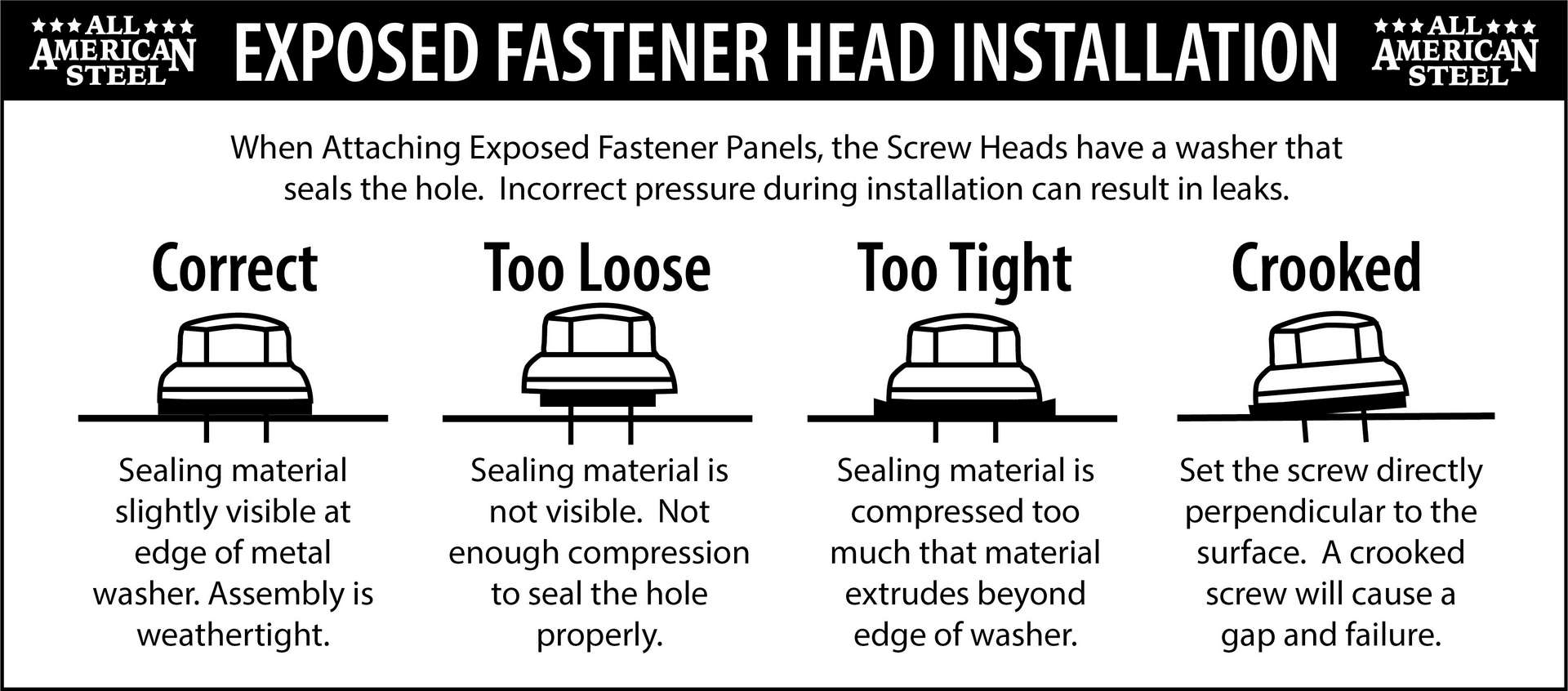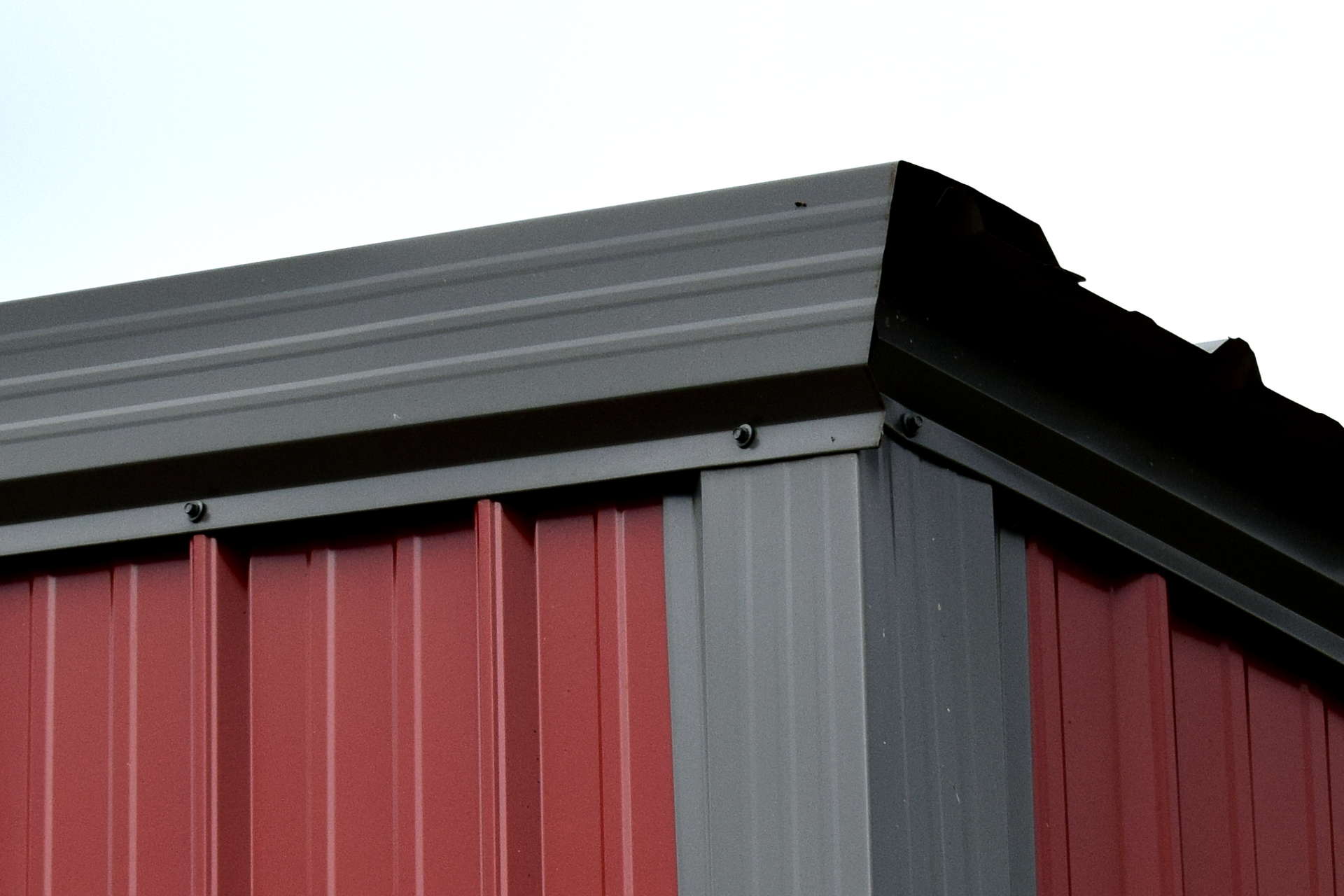So much time is spent on the panels themselves when discussing a metal roof or siding for a building, but an overlooked topic might be the system’s fastener screws. Whether it’s a residential, commercial, storage or an agricultural building, many factors must be put into consideration for choosing something that seems as simple as the fastener screws.
The substructure or material type that the fastener screws attach to is just as important of a factor, and it may vary depending on if it’s a residential, commercial, or agricultural building.
Factors To Consider When Choosing Metal Roofing Fastener Screws
- Type Of Panel System (exposed vs. concealed fastener)
- Screw Coating And Material it’s made of
- Screw Length Needed
- Type Of Screw Needed
- Screw Drill Points, Sizes & Head Types
- Screw Thread Count
- Screw Colors
Let’s first address a few things to know about fastener screws. Some topics will see more detail below.
- Diameter – The shank diameter (not the diameter of the screw head).
- Threads Per Inch – Unit of Measurement for screw threads. Example: A screw that’s a #12-14 is a #12 diameter with 14 threads per inch.
- Length – Starts from the underside of the head and includes the drill point & sealing washer. The head style is included in the length on countersunk fasteners only.
- Head Style – The most common metal roofing screws are hex head, hex washer head, and pancake head.
- Drill Point Style – Self-drilling, self-tapping, and self-piercing
- Material – Carbon steel and stainless steel are the most common.
- Coating – Galvanized screws are the most common. The screw head is usually painted the same color as the metal panels for appearance purposes.
- Sealing Washers – The screws will either have a rubber sealing washer for weather-tightness or will not.
- lbf – Pound-Force. A nontechnical unit of force equal to: the mass of 1 pound with an acceleration of free fall, equal to 32 feet/sec/sec. The strength of screws are measured in units of lbf.
Fastener Screws Drill Points
One of the most misunderstood or overlooked parts of a screw is the drill point itself. It’s common for customers to use all of these terms interchangeably. Self-drilling and self-tapping screws are often confused for being the same, but they are not.
There are several similarities between the two, including the fact that both are often made in the same sizes and head types. However, they serve different purposes, and if you order the wrong drill point then your screw may not function correctly.
There are three basic types of screw drill point styles: Self-Drilling, Self-Tapping, and Self-Piercing
Self-Drilling Screws
The tip of self-drilling screws will have a drill point that is capable of drilling a hole while forming the mating threads. It must be able to perform both things in a single operation. A self-drilling screw must drill its own hole to be considered self-drilling. It’s used in metal to metal applications.
Self-Tapping Screws
Self-tapping screws are designed to tap threads into the material. They are not designed to drill through metal, and you must pre-drill a pilot hole prior to installation. Applications can be used on both metal and wood, but they are rarely used for metal roofing and siding projects.
Self-Piercing Screws
This is a screw that is designed to serve two functions: to pierce a light gauge metal and tap threads into the material. The drill point will be sharper and has two threads. You don’t need to pre-drill a pilot hole prior to installation. These are the most common type of metal to wood screws.

Choosing The Screw Head For Your Fastener Screws
Fasteners come in different profiles that each serve different purposes.
The variety of heads on fastener screws may include:
- Hex Washer Head – The washer face provides a bearing surface for the driving socket. These can be slotted or unslotted, although unslotted is more common.
- Pan Head – A low profile head that can be a Phillips or a square drive.
- Flat Head – This head type sinks into wood for a flush finish.
- Oval Head – Similar to a flat head, but with an oval on top for a finished look.
- Round Washer Head – Consists of a raised pan head with an integral washer formed during the heading process. The head of the screw helps prevent it from being over-driven.
- Truss Screws – Screws with a large head and low profile.
- Flat Truss Head Screws – This is the lowest profile head available for attaching metal to metal.
- Wafer Head – Used to attach plywood to metal.
- Drywall Bugle Head – These will fasten drywall to metal studs.
- Pan Framing – A stud-framing screw for attaching stud to track.
- Pancake Head – A very low profile head with a large bearing surface.
- Square Trim — A square drive and reduced head for tight spaces.

Determining The Correct Screw Length For Metal Roofing
If your fastener screws aren’t long enough to penetrate through all of your material, it’s safe to say you’re not going to have a successful installation. The right fasteners must not only be long enough to go through the material, but you must also take into account the length of the drill bit if you are using self-drilling screws.
Most importantly, you want a minimum of one inch of screw penetration into the material that you are fastening to.
The length is usually rounded up to the next half or quarter inch to ensure the fastener screws are long enough. Keep in mind that the longer the screw, the more torsional strain is produced during driving. Sometimes this can cause the fasteners to break during installation.
Length of Fastener Screws For Metal Roofing
The length of the fastener screws is measured differently depending on whether the screw is a hex head or a flat head. Hex head screws will be measured from the bottom of the hex head and flat head screws are measured from the top of the screw head.
Different climates and load requirements mean that the screw length will not always be the same. Every job should be treated uniquely and not as a “one size fits all.”
Here are some general examples:
- Standing Seam Metal Roofing – 1” pancake heads are the most typical screws to fasten the concealed clips.
- ½” Corrugated – The screw will fasten to the high of the of the panel rib in a roofing application. If this panel is ½” in height, you would need at least a 1.5” long screw.
- ⅞” Corrugated – The screw will fasten to the high of the panel in a roofing application. The corrugated roofing is ⅞” in height, so you will need at least a 2” long screw.
- R Panel – The screw will fasten to the low of the panel. Screws that are 1” in length are the most common.
Screw Lengths For Metal Siding
Just like a metal roof, the requirements of the job will always vary. Always check with your engineer or architect. Here are some general guidelines:
- Concealed Fastener Wall Panels – 1” pancake heads are the most typical screws.
- Exposed Fastener Panels – The screw will fasten to the low of the panel. Screws that are 1” in length are the most common.
What type of material are you attaching to?
METAL-TO-WOOD
Wood Purlins
The most common type of metal roofing fastener screws are metal-to-wood roofing screws. Fastener manufacturers usually specify pull-out strengths for a variety of different types of wood as not all wood is the same. This helps to determine the right fastener for your project. These screws have an extra sharp self-piercing point that can penetrate 20-29 gauge steel sheeting and then into the wood without pre-drilling, slipping, or damaging the metal panels.
When attaching metal panels to wood purlins, such as a typical 2” x 4”, a #9 fastener offers good pull-out values at an economical price.
This type of fastener has the following specifications:
- 15 threads per inch
- .180” Diameter
- Self-drills through steel up to 24 Ga. thick
- Offers a 542 lbf pull-out value when it penetrates the wood purlin by at least 1.”
OSB/Plywood Decking
Switching from wood purlins to OSB or plywood decking changes the fastener recommendation from a #9, as discussed previously, to a #12.
This type of fastener has the following specifications:
- 8 threads per inch (almost half of the #9 discussed above)
- .212” Diameter (15% thicker than the #9 discussed above)
- Self-drills through steel up to 24 Ga. thick
Pull out values will vary significantly based on decking type and thickness.
¾” plywood offers a 583 lbf pull-out value while ¾” OSB drops to a 412 lbf value. That equates to 30% lower performance when the same fastener is installed into a different type of wood substrate.
What’s the Downside to Using a #12 fastener?
Given the larger shank diameter and thread style, #12 fasteners cost approximately 25%-30% more than #9 fasteners. While the cost is higher, most consumers can easily justify spending a few hundred dollars more on the overall project budget to gain stronger pull-out values.
In rare cases, availability in the supply chain can be an issue. Given sales history data, most manufacturers stock both #9 and #12 fasteners in inventory to offer their customers proper product selection when needed.
Not all “wood” substrates offer the same pull-out values. Consequently, education is crucial. Manufacturers and contractors must educate building owners on the importance of selecting the most appropriate fastener for the substrate and project instead of using the cheapest or most common.
METAL-TO-METAL
There is more than one type of screw that you can use when you attach to metal or steel. The correct fastener screws to use is based on the application and the thickness of the steel.
Types of Metal-To-Metal Roofing Screws
- Screws that fasten the sidelap of the metal panels or attach the trim and flashing.
- Screws that attach to light gauge metal such as metal purlins.
- Screws that attach to heavy steel joists, I-beams, or steel tubes.
Choosing The Right Screw For Your Metal Panels
It’s important to take note that something as small and simple as screws and fasteners are easy to disregard as a vital component of a construction project. For metal roofing or siding, fasteners make up less than 1% of the total cost of the project, yet they can attribute to 100% of the roof’s failure.
Your roof can fail from broken fasteners, incorrectly installed fasteners, worn out sealing washers, or a major oversight in using the wrong screws.
At All American Steel, we manufacture metal roofing and metal siding panels for a many different types of projects, including Agricultural, Commercial and Residential projects.
There are many different factors you have to consider when choosing the right screw for your metal roofing or siding project and choosing to contact the team at All American Steel through our website or by calling 608-372-7200 is a great first step.


Sources / Article Contributions:
Western States Metal Roofing & McElroy Metal

